Council may finally bid adieu to ADU deliberation
Thursday, October 15, 2015 by
Elizabeth Pagano After more than a year, City Council is closing in on new regulations for accessory dwelling units that, ostensibly, will make it easier for Austinites to build small, secondary homes on their property.
As Council Member Greg Casar announced at Tuesday’s work session, “It’s been such a long process, and we’re finally here, sort of at the end of it.”
The proposed ordinance was introduced under the former City Council. In June 2014, that Council approved a resolution by former Council Member Chris Riley that was intended to remove barriers to construction of ADUs of 500 square feet or less. Now Council will consider approving the final ordinance, which lingered at the Planning Commission and its Codes and Ordinances committee for nearly a year and weathered three separate meetings of the City Council Planning and Neighborhoods Committee.
A lot has changed in the past 16 months. In a methodical approach to the new Council committee system that remains slightly unbaked, Planning and Neighborhoods Committee Chair Casar opted to hear the ordinance multiple times, separating the more controversial items from those that provoked protest last summer.
The result is a laundry list of committee-approved recommendations in addition to the ordinance put forward by the Planning Commission.
The Council committee dove headfirst into the more controversial aspects of the proposed ordinance, recommending that it be applied citywide, not on an opt-in (or opt-out) basis for individual neighborhoods. The recommendations reduce the minimum lot size from 7,000 square feet to 5,750 square feet and the minimum zoning from Single Family-3 to Single Family-2.
The recommendations also introduce a new type of short-term rental: “STR IB.” These short-term rentals, though technically owner-occupied, would be included in the 3 percent cap with commercial Type II STRs. Unless issued before January 2016, Type II STRs would not be allowed in ADUs.
A recommendation from the Planning Commission, which requires one parking space per ADU with grandfathering for properties with existing ADUs, will stand.
The recommendations also set the floor-to-area ratio at O.15 maximum within the areas of the city covered by the McMansion ordinance. Casar explained this recommendation, which is a departure from the 500-square-foot understanding of ADUs, at Tuesday’s Council worksession.
“That basically means that you can build a normal-sized ADU if you have a normal-sized lot, but if you have a larger-than-average-sized lot, then you can build a somewhat-larger ADU. But you could never build a larger ADU than you could an extension to your house,” said Casar.
“What really convinced me is that there are lots of places where you can build an 800-square-foot extension to your house, but you weren’t allowed to put a door on it and separate it from your house,” Casar continued. “If your in-laws are particularly pesky, you can create a space between the house and the ADU and put a door on it.
“I think that we have gotten some emails from people concerned that doing this would allow people to go over the maximum allowed impervious cover or allow people to go beyond … a size they would be allowed under McMansion. That wasn’t what was recommended. We are just saying if you can build an extension to your house, you should be able to make it a granny flat,” Casar concluded.
The committee also put together some recommendations that were considered less controversial. Those recommendations ask staff to explore financing options for constructing ADUs in order to assist low- and moderate-income property owners with building and suggest establishing preapproved guidelines for constructing ADUs. The guidelines are intended to simplify both the building and inspection process.
The recommendations also include codifying the requirements for water and wastewater lines and meters for ADUs.
Though the committee voted in favor of a preservation bonus intended to incentivize the retention of existing buildings on properties, that recommendation remains in limbo, as it is still unclear how that would be implemented.
You're a community leader
And we’re honored you look to us for serious, in-depth news. You know a strong community needs local and dedicated watchdog reporting. We’re here for you and that won’t change. Now will you take the powerful next step and support our nonprofit news organization?










